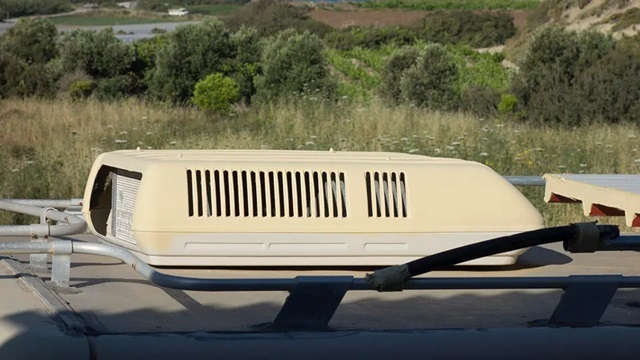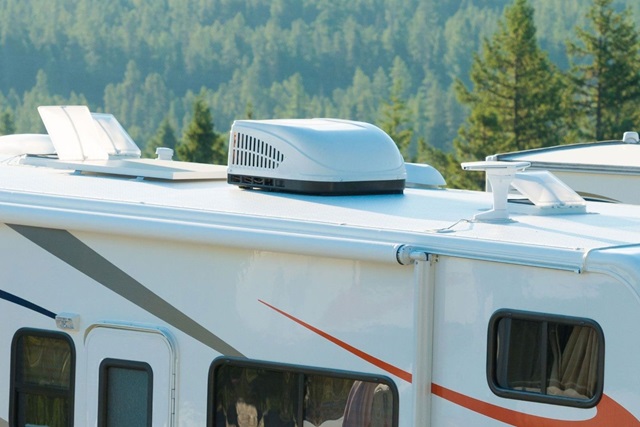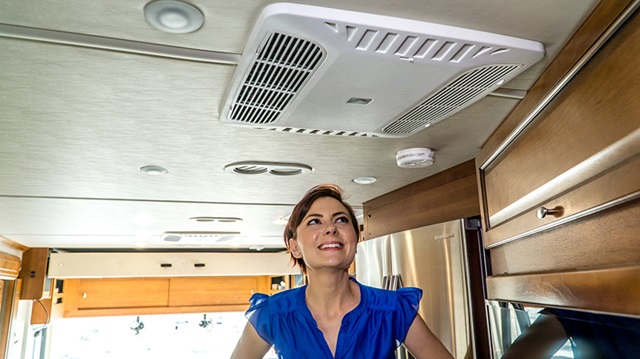Whether you’re going on a cross-country adventure or simply relaxing on a weekend getaway, keeping your RV cool and comfortable is essential if you want to enjoy your journey to the fullest. That’s where the right AC comes in, your trusted companion in the battle against the sweltering heat. In this guide, I’ll delve into everything you need to know about getting one, from choosing the right size and type to energy efficiency and installation.
But first, when looking to beat the heat while on the road, check out these RV air conditioners on sale and snag a great deal on high-quality gear. These sleek, modern designs will cool your vehicle while adding a touch of style to the interior. Plus, with their quiet operation, you can enjoy a peaceful environment while staying comfortably cool. The lightweight construction makes installation a breeze and ensures you don’t have to sacrifice precious cargo space for comfort.

Roof-Mounted or Built-In

So, what’s the best AC for an RV? When it comes to outfitting your caravan with the perfect cooling solution, choosing between a rooftop and built-in RV AC unit is a big decision and each option has its perks. Rooftop units sit snugly atop your vehicle and leave your precious interior space untouched. That means more room for sleeping quarters or storage, which is always a plus when you’re living life on the road.
Plus, they’re known for their excellent airflow and cooling performance. Positioned up high, they have easy access to fresh air, pulling it in and pushing out the warmth efficiently. And with adjustable louvers, you can direct that cool breeze exactly where you need it, so every nook and cranny of your vehicle stays refreshingly cold.
On the flip side, built-in RV air conditioners offer a different kind of charm. Integrated seamlessly into your RV’s interior, they bring a touch of sophistication to your mobile abode. Picture sleek lines and a cohesive look that blends seamlessly with your caravan’s aesthetic. Not to mention, built-in units are often quieter than their rooftop counterparts, which ensures peaceful nights of sleep no matter where your adventures take you. Plus, they often come loaded with extra features like built-in thermostats and remote controls that put total temperature control at your fingertips.
So, which one is right for you? This comes down to your personal preferences and priorities. Are you all about maximising space and airflow? A rooftop unit might be your best bet. Are you after a sleek, integrated look with added convenience features? In that case, a built-in unit could be ideal for you. Whichever you choose, with the perfect design on board, you’ll stay cool and comfortable on even the hottest adventures.
Power
When it comes to selecting the right RV air conditioner, cooling power is key. You wouldn’t bring a fan to a sauna and expect it to keep you cool. Similarly, you need an AC unit that can handle the size of your vehicle and the intensity of the climate you’ll be traveling through. For larger RVs with more space to cool, you’ll want a device with a higher cooling power. After all, you need that refreshing breeze to reach every corner of your home on wheels. However, if you’re rolling with a smaller vehicle, you can get away with a less powerful device.
But it’s not just about the size of your vehicle, it also depends on where you’re planning to take it. If your adventures will lead you to scorching hot destinations, you’ll need a device with hefty cooling chops to battle the heat. There’s nothing worse than sweating it out in your vehicle while the sun beats down outside.
Size

It’s crucial to measure the available space where you plan to install your RV AC. You don’t want to end up with a unit that takes up valuable real estate inside your vehicle or struggles to keep you cool on the sweltering summer days. Think about any obstructions, like cabinets or fixtures, that could get in the way of installation.
Once you have those measurements in hand, it’s time to compare them with the dimensions provided by the manufacturer. Think of it like finding the perfect puzzle piece to complete your vehicle’s comfort puzzle. You want a device that slides right into place without any fuss or frustration.
Electricity Usage
Not every RV AC unit is the same when it comes to electricity consumption. The amount of it they use varies depending on factors like cooling capacity, energy efficiency rating, and usage patterns. That’s why it’s essential to do your homework and understand the power requirements of the unit you’re eyeing. Look for units with high energy efficiency ratings. These consume less electricity while still delivering top-notch cooling performance. And who doesn’t love saving a little extra cash on their energy bill?
Energy-efficient units often come with nifty features that help you squeeze even more savings out of your electricity usage. Think programmable timers, sleep modes, and adjustable fan speeds – all these help you tailor your cooling experience to fit your specific needs.
Ease of Installation
If you’re eyeing a rooftop RV AC unit, you’ll want to make sure your vehicle’s roof can handle the weight and has enough room for the unit to snugly fit. Check out the manufacturer’s guidelines for installation, and if you’re feeling a bit shaky about it, don’t hesitate to call in the pros for a little extra help.
Now, if a built-in unit is more your style, you’ll need to measure up the space inside your vehicle. Think of it like interior decorating—except instead of choosing throw pillows, you’re figuring out where to place your AC. Consider factors like ventilation needs and accessibility for maintenance or repairs. And don’t forget to check if you need to make any modifications to make room for the new device.

















